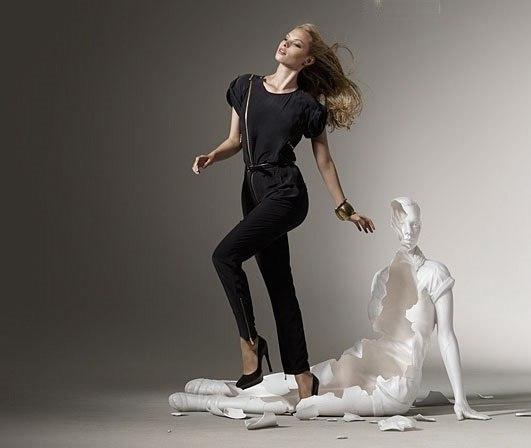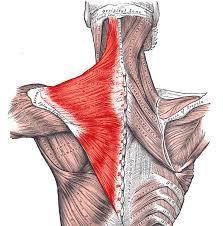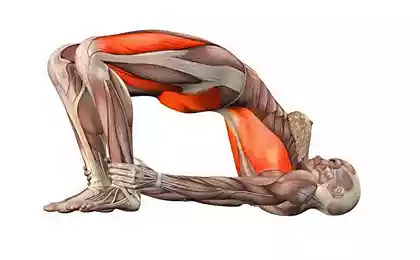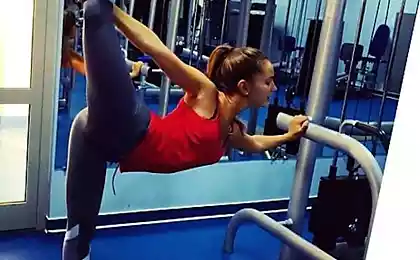1055
Emotional stress and muscle clips
Feelings, emotions and outlook affect the physical body, health and well-being. The body is like a mirror reflecting our psycho-emotional state. We carry out a self-test and identify pockets of muscle tension and power units. After eliminating the cause, you can cope with the consequences.
The reason for the gain of muscle tension in people - constant mental and emotional stress. Perform a self-test ... Ponder, mind and body - a unit, every feature of human nature has its corresponding physical posture.
The character is expressed in the body as muscular rigidity (excessive muscle tension, from the Latin rigidus -. Solid) or muscular armor
.

Chronic stress blocks the energy flows that underlie strong emotions;
Blocked emotions can not be expressed and form clots specific memories with strong emotional charge of the same quality, which contain condensed experiences and related fantasies from different periods of human life.
Removing muscle clamp releases significant energy, which manifests itself as a feeling of heat or cold, tingling, itching or emotional recovery. Tselezatravlennost - condition of modern man.
Imposed ideals of material prosperity and comfort, the conditions for achieving them, focus on the end result, rather than to live in the present moment - keep people in constant tension. Hence muscle clamps & gt; spasm of blood vessels & gt; hypertension, low back pain, ulcers and more.
Everything else - causes secondary
. Muscle function pantsirya- protection displeasure. However, the body pays for this protection decrease in their ability to pleasure.
Muscle shell is formed of seven conventional segments, consisting of muscles and organs. These segments are located in the area of the eyes, mouth, neck, chest, diaphragm, abdomen and pelvis.
Removing muscle clamps is achieved through:
- The accumulation of energy in the body;
- Direct impact on chronic muscle blocks (massage);
- Expression of emotions released, which in this case are revealed;
- Spontaneous movement, tantseterapiya, relaxation exercises, yoga, qigong, holotropic breathing, etc.
. 1. Eyes. Protective shell appears motionless forehead and "empty" expression of eyes that seemed to look out of the fixed mask. Blooming carried uncovering eyes as wide as possible to enable the eyelids and forehead; gymnastics for the eyes.
2. Roth. This segment includes the group of muscles of the chin, throat and neck. The jaw may be either too tight or unnaturally relaxed. Segment keeps crying expression, shouting, anger. Remove the muscle tension is possible by simulating crying, movements, lips, biting, grimacing and massage the muscles of the forehead and face.
3. Neck. It includes deep muscles of the neck and tongue. Muscle unit holds mostly anger, screaming and crying. The direct impact on the muscles in the neck depth is not possible, therefore, to eliminate muscle clamp allows shouts, singing, gagging, protruding tongue, bending and rotation of the head, etc.
4. Thoracic segment: broad chest muscles, shoulder muscles, shoulder blades, chest and hands. Suppressed laughter, sadness, passion. Control of breathing - a means of suppressing any emotion. Carapace dissolved work of breathing, especially the implementation of a full exhalation.
5. Aperture. This segment includes the diaphragm, solar plexus, internal organs, muscles, vertebrae that level. Carapace is expressed in curved spine forward. Exhale is difficult inspiration (as in asthma). Muscle unit holds strong anger. It should largely dismiss the first four segments, before moving on to become loose it.
6. Belly. The abdominal muscles and back muscles. Strain of lumbar muscles associated with the fear of an attack. Muscle clamps on the sides associated with the suppression of anger, hostility. Blossoming shell in this segment is relatively easy if the upper segments are already open.
7. Taz. The last segment includes all the muscles of the pelvis and lower extremities. The stronger the muscle spasm, especially the pelvis is pulled back. The gluteal muscles are tense and painful. Pelvic shell is suppressing arousal, anger, pleasure.
Sectors muscle clamps:
ZONE NECK Neck - a very important area, and a kind of barrier between the conscious and the Bridge (head) and unconscious (the body). The rationality inherent in Western culture, sometimes causes us to place undue reliance on own mind. According to the research, studying how people perceive their body size of the head in an internal representation takes an average of 40-60% of body size (whereas objectively, anatomically - about 12%). This "imbalance" caused by excessive mental activity, the ongoing "mental chatter", giving the impression that the head is full and can not be restored or relax. This generated head texts "do not reach" to the body, and the body is simply ignored consciousness - a situation "alone", a kind of "Professor Dowell's head." In this case, it is important to focus the customer's attention to the signals given by the body to the thoughts associated with feelings.
There is a reverse version "of the cervical barrier": there are sensations in the body, and bright enough, but they are not interpreted, do not go to the level of awareness. For this situation is characterized by a variety of pain psychosomatic origin, paresthesia, etc., The reasons for which the person does not understand.
Gorlov ZONE located in the region of the jugular notch and is associated with emotions locked. There are recognized problems of interaction with others (communication) or with oneself (authenticity). This unit can occur if a person gets into a situation where it is impossible to admit himself to some unpleasant truth, or do something that threatens to destroy its identity ( "if I do - it will not be me"). Also in this area reflects the impossibility of a ban on the realization of some important truths (ie the ban on uttering meaningful text or a ban on certain actions: "If I say / do - it will not be me"). Long-existing problems in this area threatens the development of thyroid disease, asthma, bronchopulmonary disorders.
MID sternum This area is located behind the sternum bone protruding below the jugular notch, and it is localized grievances area. Subjectively, the feeling may be perceived as someone here, a ball, a clot, "stone heart". This really is an overload channel pericardium, heart disorders arise. For a man with such a problem, and is characterized by a specific facial expression - pronounced nasolabial folds, drooping corners of her mouth - all this develops into a mask of distrust world grievances.
BREAST CENTER In the Eastern tradition, in the middle of the chest at the level of the heart is the heart chakra, Anahata - the focus of love and emotional openness to the world. If a person's life is no place for love, there is nothing basic feeling - grief, which causes pulling, sinking feeling in the area. Also, customers can describe it in the presence of a stale, compressed cold, dark "substance". The defeat of this zone are usually associated with large-scale psychological trauma received in childhood - in the first place, with coldness of parents, children and others leave
. Phrenic AREA Captures zone diaphragmatic muscles and the epigastric region. The body-oriented therapy, this area is associated with the blocking, the ban on any expression of emotions - both good and bad. There is also rooted fears of financial distress and social exclusion. When working with this area can be felt even when the volume retracted abdomen. Voltage is like the feeling after hitting "below the belt" - breathing becomes shallower, "frozen" emotions, crying, laughing. Protective reaction of the organism to the clamping formation (which is associated with the stagnation of the blood, lymph, etc.) Is often the formation of fat cushions. Also, quite often there are psychosomatic stomach ulcer, liver problems (liver in China was considered a source of anger), gallbladder. Clip in the diaphragm area is typical for people who want to control everything, to keep themselves. They are typical of such locutions as "I can not afford to allow this", "for all the pleasure you have to pay", and so on. N. Also, such people tend to discuss what is happening constantly generate intellectual constructions, to see life through the lens of schemes.
This fear AREA umbilical area, which corresponds to the so-called "belt Reich", including projection and kidneys. The Chinese called kidney "graveyard of emotions" and the cold source. After working in this area (as used here long "push" movement), the client can feel the cold redistribution of the body.
From the back of the pelvic CLIP is the area of the sacrum, buttocks, iliac crest, the front - lower abdomen and inner thighs. Reich tied pelvic clamp with locked sexuality. If the sexual life is no deep discharge, giving a sense of integrity, then there is a deep spasticity, fat, congestion in the pelvic area. In the presence of a pelvic clamp many techniques for working with body fat poor results because, as already mentioned, they are formed as a protective reaction of the organism. Frontal clamping - (helmet nevrostenika), with constant, long-term stresses, general fatigue.
Clamp Jaw - jaw is compressed (aggression)
Neck - degitalnost - concentrating feelings of ambivalence, ambiguity.
Breast Clip - Bronchitis, asthma, area of conflict between the wish and need to.
The middle of the chest - zone offense.
Diaphragm clamp - blocking emotions (keeping it all inside, psychosis zone).
Fear Zone - Fear affects the kidneys and bladder.
Pelvic clip - Underbelly, glutes.
The reason for the gain of muscle tension in people - constant mental and emotional stress. Perform a self-test ... Ponder, mind and body - a unit, every feature of human nature has its corresponding physical posture.
The character is expressed in the body as muscular rigidity (excessive muscle tension, from the Latin rigidus -. Solid) or muscular armor
.


Chronic stress blocks the energy flows that underlie strong emotions;
Blocked emotions can not be expressed and form clots specific memories with strong emotional charge of the same quality, which contain condensed experiences and related fantasies from different periods of human life.
Removing muscle clamp releases significant energy, which manifests itself as a feeling of heat or cold, tingling, itching or emotional recovery. Tselezatravlennost - condition of modern man.
Imposed ideals of material prosperity and comfort, the conditions for achieving them, focus on the end result, rather than to live in the present moment - keep people in constant tension. Hence muscle clamps & gt; spasm of blood vessels & gt; hypertension, low back pain, ulcers and more.
Everything else - causes secondary
. Muscle function pantsirya- protection displeasure. However, the body pays for this protection decrease in their ability to pleasure.
Muscle shell is formed of seven conventional segments, consisting of muscles and organs. These segments are located in the area of the eyes, mouth, neck, chest, diaphragm, abdomen and pelvis.
Removing muscle clamps is achieved through:
- The accumulation of energy in the body;
- Direct impact on chronic muscle blocks (massage);
- Expression of emotions released, which in this case are revealed;
- Spontaneous movement, tantseterapiya, relaxation exercises, yoga, qigong, holotropic breathing, etc.
. 1. Eyes. Protective shell appears motionless forehead and "empty" expression of eyes that seemed to look out of the fixed mask. Blooming carried uncovering eyes as wide as possible to enable the eyelids and forehead; gymnastics for the eyes.
2. Roth. This segment includes the group of muscles of the chin, throat and neck. The jaw may be either too tight or unnaturally relaxed. Segment keeps crying expression, shouting, anger. Remove the muscle tension is possible by simulating crying, movements, lips, biting, grimacing and massage the muscles of the forehead and face.
3. Neck. It includes deep muscles of the neck and tongue. Muscle unit holds mostly anger, screaming and crying. The direct impact on the muscles in the neck depth is not possible, therefore, to eliminate muscle clamp allows shouts, singing, gagging, protruding tongue, bending and rotation of the head, etc.
4. Thoracic segment: broad chest muscles, shoulder muscles, shoulder blades, chest and hands. Suppressed laughter, sadness, passion. Control of breathing - a means of suppressing any emotion. Carapace dissolved work of breathing, especially the implementation of a full exhalation.
5. Aperture. This segment includes the diaphragm, solar plexus, internal organs, muscles, vertebrae that level. Carapace is expressed in curved spine forward. Exhale is difficult inspiration (as in asthma). Muscle unit holds strong anger. It should largely dismiss the first four segments, before moving on to become loose it.
6. Belly. The abdominal muscles and back muscles. Strain of lumbar muscles associated with the fear of an attack. Muscle clamps on the sides associated with the suppression of anger, hostility. Blossoming shell in this segment is relatively easy if the upper segments are already open.
7. Taz. The last segment includes all the muscles of the pelvis and lower extremities. The stronger the muscle spasm, especially the pelvis is pulled back. The gluteal muscles are tense and painful. Pelvic shell is suppressing arousal, anger, pleasure.
Sectors muscle clamps:
ZONE NECK Neck - a very important area, and a kind of barrier between the conscious and the Bridge (head) and unconscious (the body). The rationality inherent in Western culture, sometimes causes us to place undue reliance on own mind. According to the research, studying how people perceive their body size of the head in an internal representation takes an average of 40-60% of body size (whereas objectively, anatomically - about 12%). This "imbalance" caused by excessive mental activity, the ongoing "mental chatter", giving the impression that the head is full and can not be restored or relax. This generated head texts "do not reach" to the body, and the body is simply ignored consciousness - a situation "alone", a kind of "Professor Dowell's head." In this case, it is important to focus the customer's attention to the signals given by the body to the thoughts associated with feelings.
There is a reverse version "of the cervical barrier": there are sensations in the body, and bright enough, but they are not interpreted, do not go to the level of awareness. For this situation is characterized by a variety of pain psychosomatic origin, paresthesia, etc., The reasons for which the person does not understand.
Gorlov ZONE located in the region of the jugular notch and is associated with emotions locked. There are recognized problems of interaction with others (communication) or with oneself (authenticity). This unit can occur if a person gets into a situation where it is impossible to admit himself to some unpleasant truth, or do something that threatens to destroy its identity ( "if I do - it will not be me"). Also in this area reflects the impossibility of a ban on the realization of some important truths (ie the ban on uttering meaningful text or a ban on certain actions: "If I say / do - it will not be me"). Long-existing problems in this area threatens the development of thyroid disease, asthma, bronchopulmonary disorders.
MID sternum This area is located behind the sternum bone protruding below the jugular notch, and it is localized grievances area. Subjectively, the feeling may be perceived as someone here, a ball, a clot, "stone heart". This really is an overload channel pericardium, heart disorders arise. For a man with such a problem, and is characterized by a specific facial expression - pronounced nasolabial folds, drooping corners of her mouth - all this develops into a mask of distrust world grievances.
BREAST CENTER In the Eastern tradition, in the middle of the chest at the level of the heart is the heart chakra, Anahata - the focus of love and emotional openness to the world. If a person's life is no place for love, there is nothing basic feeling - grief, which causes pulling, sinking feeling in the area. Also, customers can describe it in the presence of a stale, compressed cold, dark "substance". The defeat of this zone are usually associated with large-scale psychological trauma received in childhood - in the first place, with coldness of parents, children and others leave
. Phrenic AREA Captures zone diaphragmatic muscles and the epigastric region. The body-oriented therapy, this area is associated with the blocking, the ban on any expression of emotions - both good and bad. There is also rooted fears of financial distress and social exclusion. When working with this area can be felt even when the volume retracted abdomen. Voltage is like the feeling after hitting "below the belt" - breathing becomes shallower, "frozen" emotions, crying, laughing. Protective reaction of the organism to the clamping formation (which is associated with the stagnation of the blood, lymph, etc.) Is often the formation of fat cushions. Also, quite often there are psychosomatic stomach ulcer, liver problems (liver in China was considered a source of anger), gallbladder. Clip in the diaphragm area is typical for people who want to control everything, to keep themselves. They are typical of such locutions as "I can not afford to allow this", "for all the pleasure you have to pay", and so on. N. Also, such people tend to discuss what is happening constantly generate intellectual constructions, to see life through the lens of schemes.
This fear AREA umbilical area, which corresponds to the so-called "belt Reich", including projection and kidneys. The Chinese called kidney "graveyard of emotions" and the cold source. After working in this area (as used here long "push" movement), the client can feel the cold redistribution of the body.
From the back of the pelvic CLIP is the area of the sacrum, buttocks, iliac crest, the front - lower abdomen and inner thighs. Reich tied pelvic clamp with locked sexuality. If the sexual life is no deep discharge, giving a sense of integrity, then there is a deep spasticity, fat, congestion in the pelvic area. In the presence of a pelvic clamp many techniques for working with body fat poor results because, as already mentioned, they are formed as a protective reaction of the organism. Frontal clamping - (helmet nevrostenika), with constant, long-term stresses, general fatigue.
Clamp Jaw - jaw is compressed (aggression)
Neck - degitalnost - concentrating feelings of ambivalence, ambiguity.
Breast Clip - Bronchitis, asthma, area of conflict between the wish and need to.
The middle of the chest - zone offense.
Diaphragm clamp - blocking emotions (keeping it all inside, psychosis zone).
Fear Zone - Fear affects the kidneys and bladder.
Pelvic clip - Underbelly, glutes.
5 ways to recognize manipulation at work
My profession - Bastard: 9 signs of relationship with this man























